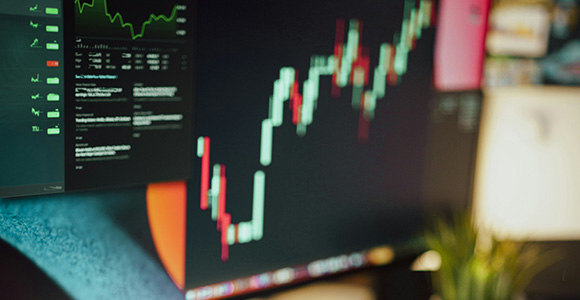Comparing Historical Data and Evaluating AI Bubble Rumors
If you’ve been paying attention to financial media lately, you’ve likely heard comparisons between today’s equity markets and the 1990s “dot-com bubble.” While these comparisons may make good headlines, today’s market and the market before the dot-com bubble burst are fundamentally different. Investors should understand a few key differences between the lead-up to the dot-com bubble burst and what is happening today.
First, it’s important to note that today’s leading companies have demonstrated the ability to generate and grow real revenue and profits. Today’s market leaders tend to have proven business models, real profits, significant positive cash flow, and a track record of growing earnings. In the late 90s, internet and electronics companies had wildly unrealistic expectations for future earnings and overhyped unproven products. They reached billion-dollar valuations without producing meaningful profits — or, in many cases, any. While there are other differences between then and now, it is crucial to understand this key difference in the quality and earning power of the companies leading the market.
While there is no single definition of a “bubble,” Goldman Sachs identifies three key components: rapidly rising asset prices, extreme valuations, and systemic risk driven by increased leverage. They also note that bubbles have historically coincided with the emergence of transformative technologies, such as the railway boom in the late nineteenth century, post-World War II radio expansion, the rise of personal computers in the late 1980s, and most recently, the internet boom of the 1990s and early 2000s. During such periods, companies entered markets with significant momentum, attracting massive inflows of investor capital even when fundamentals were weak. Investors often experience fear of missing out (FOMO) and will overlook business fundamentals in pursuit of the next “hidden champion.”
While there are surface-level similarities, today’s financial markets and corporations are in a very different position than they were 25 years ago. For starters, corporate balance sheets are far stronger. Since the great financial crisis of 2008, U.S. corporations have become net savers. In the second half of 2023 and into 2024, the nonfinancial corporate financial surplus averaged roughly $540 billion, meaning companies generated more cash than they spent on investment.
Today’s leading technology companies are earning substantial revenues and profits, unlike many of the high-flying names during the dot-com bubble. At a 2024 press conference, Federal Reserve Chair Jerome Powell was asked whether he saw signs of a bubble, to which he replied: “This is different in the sense that these companies, the companies that are so highly valued, actually have earnings and stuff like that.” He went on to emphasize that AI-related spending has been a key driver of economic growth.
To put this in perspective, consider a few examples from the late 1990s. Pets.com, an e-commerce site for pet supplies backed by Amazon, went public in 2000 at a valuation of $82.5 million. It entered a market that was not yet established and operated at negative margins —i.e., losing money on every sale. They massively overspent on infrastructure expansion, marketing, and employee compensation packages. Within a year, it went bankrupt after briefly reaching a market cap of $400 million. Similarly, Webvan, an online grocery delivery service, raised $375 million in its 1999 IPO and reached a market cap of $1.2 billion. By 2001, before achieving profitability, it had burned through roughly $850 million to $1.2 billion in private funding. It was forced to shut down after overspending and mismanaging its infrastructure buildout, all without a viable customer base, or realizing any profits.
The dot-com bubble was built on companies with little to no revenue streams, weak business models, and little financial discipline. By contrast, today’s AI-driven leaders, companies like Microsoft, NVIDIA, and Alphabet (Google), are reporting record-breaking revenue growth, significant capital investment, and clear, monetizable business models. Furthermore, regulatory oversight and corporate transparency have both improved substantially, reducing the likelihood of the financial malpractice that contributed to the 2000 crash.
Another essential comparison is valuation. While today’s equity markets are richly valued, especially in high-growth areas like AI, valuations are far more grounded than they were before the dot-com bubble burst. A common valuation metric is the price-to-earnings (P/E) ratio, which compares a company’s share price to its earnings per share (EPS). For example, if a company earns $10 million with one million shares outstanding, its EPS is $10. If the stock trades at $110 per share, its P/E ratio is 11×.
With that in mind, valuations are significantly lower than during the peak of the dot-com bubble. At their peak valuations in 1999, Cisco traded at approximately 206×, Nokia at 192×, and Oracle at 130×. By contrast, the top five Nasdaq companies today—NVIDIA at ~59×, Apple at ~36×, Microsoft at ~36×, Alphabet at ~27×, and Amazon at ~35×—trade at far more sustainable valuations despite their much larger scale and profitability. The Nasdaq-100 Index reached a P/E ratio of around 200× in March 2000, just before the bubble burst, while the broader Nasdaq Composite Index also surpassed 100×, roughly four times its historical average. As of October 31st, the Nasdaq-100 sits at a multiple of 34x. Which is slightly above its historical average of 20-25x, predominately driven by the exponential growth in technology stocks, all while remaining drastically below the dot-com bubble levels. It should also be noted that Oracle’s stock, while still trading slightly above its 3-year average of 34.7x due to recent sentiment and its status as a key beneficiary of the AI buildout, trades at a P/E of roughly 60x. While such speculative valuations still appear in isolated sectors—such as small-cap AI or biotech stocks- the companies trading at those levels no longer approach the scale of today’s dominant market leaders.
On August 1, the S&P 500 traded at a P/E ratio of about 28×. Excluding the “Magnificent Seven,” that number drops to roughly 24×, according to Bloomberg News. While this is still slightly above the long-term average of 21× dating back to 1990, today’s valuations, though elevated, are supported by real earnings, strong free cash flow, and measurable productivity gains. The companies leading the current market rally are profitable, cash-rich, and reinvesting in technologies that improve efficiency and drive sustainable growth rather than simply chasing hype.
While it’s tempting to draw parallels to the dot-com bubble, such comparisons overlook key structural and financial differences that make today’s market fundamentally more resilient. Companies leading the current technological wave have proven profitability and massive scalability. Valuation risk is far more contained, and the investor base is broader and more institutionally educated. Discussing previous market failures remains valuable—it helps investors stay defensive, diversify risk, and make proactive rather than reactive decisions. Timing the market is impossible, but staying invested, even during volatility, has historically outperformed attempts to time entries and exits.



